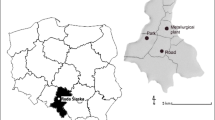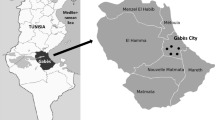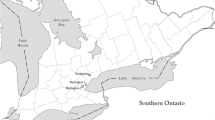Abstract
Fluoride is the most phytotoxic atmospheric pollutant. The objective of this study was to evaluate the effects of fluoride emissions by an aluminum smelter on three plant species endemics to Brazil, located at Parque Estadual do Itacolomi (PEI). The monitored species were Byrsonima variabilis (Malpighiaceae), Myrceugenia alpigena (Myrtaceae), and Eremanthus erythropappus (Asteraceae), which were monitored during 9 months using passive biomonitoring at five different locations with different distances from the smelter. The monitored species did not show macroscopic phytotoxicity damage to fluoride; however, they did show microscopic damage. The species closer to the smelter presented more severe anatomic damages, such as rupture of cell walls, protoplast retraction, and trichome alterations. Damaged stomatal ledges, flaking epicuticular wax, and damages to trichomes were observed. M. alpigena showed a higher accumulation of fluoride than the other species at all monitored sites. The test for cell death with Evans Blue was positive for the three studied species. Through biomonitoring in the PEI, we concluded that the emissions from the aluminum smelter affect the native vegetation and that due to the greater accumulation of fluoride and the diversity of microscopic damage in M. alpigena, the use of this species in the monitoring of environments polluted by fluoride is enhanced.








Similar content being viewed by others
Data availability
The datasets used and/or analyzed during the current study are available from the corresponding author on reasonable request.
References
Ahmad MN, VandenBerg LJL, Shah HU, Masood T, Büker P, Emberson L, Ashmore M (2012) Hydrogen fluoride damage to vegetation from peri-urban brick kilns in Asia: a growing but unrecognised problem? Environ Pollut 162:319–324. https://doi.org/10.1016/j.envpol.2011.11.017
Alves ES, Moura BB, Pedroso ANV, Tresmondi F, Domingos M (2011) The efficiency of tobacco Bel-W3 and native species for ozone biomonitoring in sub-tropical climate, as revealed by histocytochemical techniques. Environ Pollut 159:3309–3315. https://doi.org/10.1016/j.envpol.2011.08.043
Anjos TBO, Louback E, Azevedo AA, Silva LC (2018) Sensibility of Spondias purpurea L. (Anacardiaceae) exposed to fluoride-simulated fog. Ecol Indic 90:154–163. https://doi.org/10.1016/j.ecolind.2018.03.005
Arndt U, Flores F, Weinstein LH (1995) Fluoride effects on plants, diagnose of injury in the vegetation of Brazil. Universidade Federal do Rio Grande do Sul, Porto Alegre, p 155
Assis CM, Silveira IL, Anizelli RCM (2003) Automonitoramento da qualidade do ar em Ouro Preto/MG. In: Congresso Interamericano de Qualidade do Ar, 3, Canoas. Anais Porto Alegre, AIDIS, ABES. 1 CD-ROM (in Portuguese, with English abstract).
Associação Brasileira do Alumínio – ABAL (Brasilian Aluminum Association) (2011) http://www.abal.org.br/estatisticas/nacionais/ (accessed on September 2020).
Baunthiyal M, Ranghar S (2014) Physiological and biochemical responses of plants under fluoride stress: an overview. Fluoride 47:287–293
Cai H, Dong Y, Li Y, Li D, Peng C, Zhang Z, Wan X (2016) Physiological and cellular responses to fluoride stress in tea (Camellia sinensis) leaves. Acta Physiol Plant 38:144. https://doi.org/10.1007/s11738-016-2156-0
Chaves ALF, Silva EAM, Azevedo AA, Cano MAO, Matsuoka K (2002) Ação do flúor dissolvido em chuva simulada sobre a estrutura foliar de Panicum maximum jacq. (colonião) e Chloris gayana kunth. (capim-rhodes)-Poaceae. Acta Bot Bras 16:395–406. https://doi.org/10.1590/S0102-33062002000400003
Coser TS, Paula CC, Wendt T (2010) Bromeliaceae Juss. nos campos rupestres do Parque Estadual do Itacolomi, Minas Gerais, Brasil. Rodriguésia 61:261–280. https://doi.org/10.1590/2175-7860201061209
Davison AW, Weinstein LH (2006) Some problems relating to fluorides in the environment: effects on plants and animals. In: Tressaud, A. (Ed.). Fluorine Environ Atmos Chem, Emiss Lithosph 1:251–298. https://doi.org/10.1016/S1872-0358(06)01008-6
Divan Junior AM, Oliva MA, Martinez CA, Cambraia J (2007) Effects of fluoride emissions on two tropical grasses: Chloris gayana and Panicum maximum cv. Colonião. Ecotoxicol Environ Saf 67:247–253. https://doi.org/10.1016/j.ecoenv.2006.06.002
Divan Junior AM, Oliva MA, Ferreira FA (2008) Dispersal pattern of airborne emissions from an aluminium smelter in Ouro Preto, Brazil, as expressed by foliar fluoride accumulation in eight plant species. Ecol Indic 8:454–461. https://doi.org/10.1016/j.ecolind.2007.04.008
Faoro F, Iriti M (2005) Cell death behind invisible symptoms: early diagnosis of ozone injury. Biol Plant 49:585–592. https://doi.org/10.1007/s10535-005-0053-2
Ferreira DF (2011) Sisvar: a computer statistical analysis system. Ciência Agrotecnol 35:1039–1042. https://doi.org/10.1590/S1413-70542011000600001
Fialho RC (1997) Acumulação foliar de fluoretos e seu significado ecológico em espécies arbóreas da Mata Atlântica, Cubatão, SP. 100 f. Dissertação (Mestrado) - Instituto de Biociências, Universidade de São Paulo, São Paulo.
Fordyce FM, Vrana K, Zhovinsky E, Povoroznuk V, Toth G, Hope BC, Iljinsky U, Baker J (2007) A health risk assessment for fluoride in Central Europe. Environ Geochem Health 29:83–102. https://doi.org/10.1007/s10653-006-9076-7
Fornasiero RB (2001) Phytotoxic effects of fluorides. Plant Sci 161:979–985. https://doi.org/10.1016/S0168-9452(01)00499-X
Fornasiero RB (2003) Fluorides effects on Hypericum perforatum plants: first field observations. Plant Sci 165:507–513. https://doi.org/10.1016/S0168-9452(03)00205-X
Fuge R (2019) Fluorine in the environment: a review of its sources and geochemistry. Appl Geochem 100:393–406. https://doi.org/10.1016/j.apgeochem.2018.12.016
Gaff DF, Okong’o-ogola O (1971) The use of non-permeating pigments for testing the survival of cells. J Exp Bot 22:756–758. https://doi.org/10.1093/jxb/22.3.756
Gerosa G, Marzuoli R, Rossini M, Panigada C, Meroni M, Colombo R, Faoro F, Iriti M (2009) A flux-based assessment of the effects of ozone on foliar injury, photosynthesis, and yield of bean (Phaseolus vulgaris L. cv. Borlotto Nano Lingua di Fuoco) in open-top chambers. Environ Pollut 157:1727–1736. https://doi.org/10.1016/j.envpol.2008.06.028
Gerrits PO (1964) The application of glycol methacrylate histotechnology: some ground principles. Leica GmbH, Germany
Gorelova SV, Frontasyeva MV (2017) The use of higher plants in biomonitoring and environmental bioremediation. In: Ansari A, Gill S, Gill R, Lanza RG, Newman L (eds) Phytoremediation. Springer, Cham. https://doi.org/10.1007/978-3-319-52381-1_5
Gupta GP, Kulshrestha U (2016) Biomonitoring and remediation by plants. In: Kulshrestha U, Saxena P (eds) Plant Responses to Air Pollution. Springer, Singapore. https://doi.org/10.1007/978-981-10-1201-3_11
Hong X, Liang H, Chen Y, Liu Y, Shi Y (2018) Distribution of fluorine in the surface dust of Wuda coal base, Inner Mongolia of Northern China. J Geochem Explor 188:390–397. https://doi.org/10.1016/j.gexplo.2018.02.012
Jha SK, Nayak AK, Sharma YK (2009) Fluoride toxicity effects in onion (Allium cepa L) grown in contaminated soils. Chemosphere 76:353–356. https://doi.org/10.1016/j.chemosphere.2009.03.044
Kamaluddin M, Zwiazek JJ (2003) Fluoride inhibits root water transport and affects leaf expansion and gas exchange in aspen (Populus tremuloides) seedlings. Physiol Plant 117:368–375. https://doi.org/10.1034/j.1399-3054.2003.00040.x
Karnovsky MJ (1965) A formaldehyfr-glutaraldehyde fixative of high osmolality for use in electron microscopy. J Cell Biol 27:137–138. https://doi.org/10.1038/srep27790
Kato T, Sato N, Hayama S, Yamabuki T, Ito T, Miyamoto M, Kondo S, Nakamura Y, Daigo Y (2007) Activation of Holliday junction-recognizing protein involved in the chromosomal stability and immortality of cancer cells. Cancer Res 67:8544–8553. https://doi.org/10.1158/0008-5472.CAN-07-1307
Klumpp A, Domingos M, Klumpp G (1996) Assessment of the vegetation risk by fluoride emissions from fertiliser industries at Cubatao, Brazil. Sci Total Environ 192:219–228. https://doi.org/10.1016/S0048-9697(96)05298-9
Klumpp A, Domingos M, Moraes RM, Klumpp G (1998) Effects of complex air pollution on tree species of the Atlantic rain forest near Cubatão, Brazil. Chemosphere 36:989–994. https://doi.org/10.1016/S0045-6535(97)10160-6
Klumpp A, Ansel W, Klumpp G, Fomin A (2001) Um novo conceito de monitoramento e comunicação ambiental: a rede européia para a avaliação da qualidade do ar usando plantas bioindicadoras (EuroBionet). Rev Bras Bot 24:511–518. https://doi.org/10.1590/S0100-84042001000500005
Koslowski TT (1980) Impacts of air pollution on forest ecosystems. Bioscience 30:88–93. https://doi.org/10.2307/1307913
Li M, Li C, Zhang M (2018) Exploring the spatial spillover effects of industrialization and urbanization factors on pollutants emissions in China’s Huang-Huai-Hai region. J Clean Prod 195:154–162. https://doi.org/10.1016/j.jclepro.2018.05.186
Louback E, Pereira TAR, Souza SR, Oliveira JA, Silva LC (2016) Vegetation damage in the vicinity of an aluminum smelter in Brazil. Ecol Indic 67:193–203. https://doi.org/10.1016/j.ecolind.2016.02.044
Matthews RA, Buikema AL, Cairns JJ, Rodgers JJH (1982) Biological monitoring part IIA: receiving system functional methods relationships, and indices. Wat Resea 16:129–139. https://doi.org/10.1016/0043-1354(82)90102-6
Mesquita GL, Tanaka FAO, Cantarella H, Mattos D (2011) Atmospheric absorption of fluoride by cultivated species. Leaf structural changes and plant growth. Water Air Soil Pollut 219:143–156. https://doi.org/10.1007/s11270-010-0694-4
Messias MCTB, Sousa HC, Scalon VR, Roschel MB, Cândido ES, Fujaco MAG (2017) Phanerogamic flora and vegetation of Itacolomi State Park, Minas Gerais, Brazil. Biota Neotrop 17:1–38. https://doi.org/10.1590/1676-0611-bn-2016-0236
Mondal NK (2017) Effect of fluoride on photosynthesis, growth and accumulation of four widely cultivated rice (Oryza sativa L.) varieties in India. Ecotox Environ Safety 144:36–44. https://doi.org/10.1016/j.ecoenv.2017.06.009
Mukherjee A, Pandey B, Agrawal SB, Agrawal M (2019) Responses of tropical and subtropical plants to air pollution. In: Garkoti S, Van Bloem S, Fulé P, Semwal R (eds) Tropical Ecosystems: Structure, Functions and Challenges in the Face of Global Change. Springer, Singapore. https://doi.org/10.1007/978-981-13-8249-9_7
O’Brien TP, McCully ME (1981) The study of plants structure principles and select methods. Termarcarphi Pty. Ltda, Melbourne, p 45
Oliva MA, Figueiredo GDE, Nees S, Stapf N (2005) Gramíneas bioindicadoras da presença de flúor em regiões tropicais. Pesqui Agropecuária Bras 1:389–397. https://doi.org/10.1590/S0100-84042005000200017
Panda D (2015) Fluoride toxicity stress: physiological and biochemical consequences on plants. Int J Bioresour Environ Agric Sci 1:70–84
Pascholati SF, Leite B (1995) Hospedeiros: mecanismos de resistência. In: Bergamin Filho A, Kimati H, Amorin L (eds) Manual de Fitopatologia – princípios e conceitos. Ceres, São Paulo, pp 417–453
Peron MV (1989) Listagem preliminar da flora fanerogâmica dos Campos Rupestres do Parque Estadual do Itacolomi, Ouro Preto/Mariana, MG. Rodriguésia 41:63–69. https://doi.org/10.1590/2175-78601989416705
Pita-Barbosa A, Sant’Anna-santos BF, Silva KLF, Azevedo AA, Rocha DI (2009) Efeitos fitotóxicos do fluoreto na morfoanatomia foliar de Brachiaria brizantha (Hochst. ex A. Rich.) Stapf e Brachiaria decumbens Stapf (Poaceae). Acta Bot Bras 23:1027–1033. https://doi.org/10.1590/S0102-33062009000400012
Pozza AAA, Alves E, Pozza EA, Carvalho JG, Montanari M, Guimarães PTG, Santos DM (2004) Efeito do silício no controle da cercosporiose em três variedades de cafeeiro. Fitopatol Bras 29:185–188. https://doi.org/10.1590/S0100-41582004000200010
Ribeiro SFC (2008) Efeitos da aplicação de flúor sobre os processos fotossintéticos em três espécies lenhosas e nativas da região de Ouro Preto – MG. 63 f. Dissertação (Mestrado em Fisiologia Vegetal) – Universidade Federal de Viçosa, Viçosa, MG
Rodrigues AA, Vasconcelos-Filho SC, Mendes GC, Rehn LS, Rodrigues DA, Rodrigues CL, Müller C (2017) Fluoride in simulated rain affects the morphoanatomy and physiology of Eugenia dysenterica (Mart.) DC. Ecol Indic 82:189–195. https://doi.org/10.1016/j.ecolind.2017.07.005
Rodrigues AA, Vasconcelos-Filho SC, Müller C, Rodrigues DA, Mendes GC, Rehn LS, Costa AC, Vital RG, Sales JF (2018a) Sapindus saponaria bioindicator potential concerning potassium fluoride exposure by simulated rainfall: anatomical and physiological traits. Ecol Indic 89:552–558. https://doi.org/10.1016/j.ecolind.2018.02.043
Rodrigues DA, Vasconcelos-Filho SC, Rodrigues AA, Müller C, Farnese FS, Costa AC, Teles EMG, Rodrigues CL (2018b) Byrsonima basiloba as a bioindicator of simulated air pollutants: morphoanatomical and physiological changes in response to potassium fluoride. Ecol Indic 89:301–308. https://doi.org/10.1016/j.ecolind.2018.02.019
Rodrigues DA, de Fátima SJ, Vasconcelos-Filho SC, Rodrigues AA, Costa AC, Rodrigues CL, Lima FH, Müller CS (2020a) Spondias mombin, a potential bioindicator of potassium fluoride pollution. Ecol Indic 114:106314. https://doi.org/10.1016/j.ecolind.2020.106314
Rodrigues DA, de Fátima SJ, Vasconcelos-Filho SC, Rodrigues AA, Teles EMG, Costa AC, Reis EL, de Carvalho Silva TA, Müller C (2020b) Bioindicator potential of Ricinus communis to simulated rainfall containing potassium fluoride. PeerJ 8:9445. https://doi.org/10.7717/peerj.9445
Romero R, Nakajima JN (1999) Espécies endêmicas do Parque Nacional da Serra da Canastra, Minas Gerais. Rev Bras Bot 22:259–265. https://doi.org/10.1590/S0100-84041999000500006
Sant’Anna-Santos BF, Azevedo AA (2007) Aspectos morfoanatômicos da fitotoxidez do flúor em duas espécies arbóreas tropicais. Rev Bras Biociências 5:48–50
Sant’Anna-Santos BF, Azevedo AA (2010) Toxicidade e acúmulo de flúor em hortaliças nas adjacências de uma fábrica de alumínio. Acta Bot Bras 24:952–963. https://doi.org/10.1590/S0102-33062010000400010
Sant’Anna-Santos BF, Azevedo AA, Silva LC, Oliva MA (2012) Diagnostic and prognostic characteristics of phytotoxicity caused by fluoride on Spondias dulcis Forst. F. (Anacardiaceae). An Acad Bras Cienc 84:689–702. https://doi.org/10.1590/S0001-37652012005000048
Sant’Anna-Santos BF, Azevedo AA, Alves TG, Campos NV, Oliva MA, Valente VMM (2014) Effects of emissions from an aluminium smelter in a tree tropical species sensitive to fluoride. Water Air Soil Pollut 225:1817. https://doi.org/10.1007/s11270-013-1817-5
Sant’Anna-Santos BF, Azevedo AA, Oliva MA, Campos NV, Gomes MP (2019) What precedes fluoride-response symptomatology: microscopic or physiological damage? Ecol Indic 107:105–560. https://doi.org/10.1016/j.ecolind.2019.105560
Sharma R, Kaur R (2018) Insights into fluoride-induced oxidative stress and antioxidant defences in plants. Acta Physiol Plant 40:10–181. https://doi.org/10.1007/s11738-018-2754-0
Silva LC, Azevedo AA, Silva EAM, Oliva MA (2000) Flúor em chuva simulada: sintomatologia e efeitos sobre a estrutura foliar e o crescimento de plantas arbóreas. Rev Bras Bot 23:385–393. https://doi.org/10.1590/S0100-84042000000400004
Temmerman L, Bell JNB, Garrec JP, Klumpp A, Krause GHM, Tonneijck AEG (2004) Biomonitoring of air pollutants with plants – considerations for the future. In: Klumpp A, Ansel W, Klumpp G (eds) Urban air pollution, bioindication and environmental awareness. Cuvillier Verlag, Göttingen, pp 337–373
Treshow M, Anderson FK (1989) Plant stress from air pollution. John Wiley and Sons Ltd, Chichester
Weinstein LH, Davison AW (2003) Native plant species suitable as bioindicators and biomonitors for airborne fluoride. Environ Pollut 125:3–11. https://doi.org/10.1016/S0269-7491(03)00090-3
Weinstein LH, Davison AW (2004) Fluorides in the environment: effects on plants and animals. CABI Publishing, Oxford, p 287
Weinstein LH, Hansen KS (1988) Relative susceptibilities of Brazilian vegetation to airborne fluoride. Pesq Agropec 23(1125-11):37
Weinstein LH, Laurence JA, Mandl RH, Waelti K (1990) Use of native and cultivated plants as bioindicators and biomonitors of pollution damage. Am Soc Test Mater Philadelphia. https://doi.org/10.1520/STP19057S
Yalaltdinova A, Kim J, Baranovskaya N, Rikhvanov L (2018) Populus nigra L. as a bioindicator of atmospheric trace element pollution and potential toxic impacts on human and ecosystem. Ecol Indic 95:974–983. https://doi.org/10.1016/j.ecolind.2017.06.021
Yepu L, Shengli W, Prete D, Suyin X, Zhongren X, Fei Z, Qian Z (2017) Accumulation and interaction of fluoride and cadmium in the soil-wheat plant system from the wastewater irrigated soil of an oasis region in northwest China. Sci Total Environ 595:344–351. https://doi.org/10.1016/j.scitotenv.2017.03.288
Acknowledgments
The authors would like to thank CAPES (Coordenação de Aperfeiçoamento de Pessoal de Nível Superior) - Finance code 001 for the scholarship granted to Thamires Fernanda Gomes. L. C. Silva thanks the Conselho Nacional de Desenvolvimento Científico e Tecnológico (CNPq) for the Research Productivity Scholarship 309308/2018-6. We also thank the direction of the Parque Estadual do Itacolomi – MG, for the free access granted to us, “Laboratório de Anatomia Vegetal” and “Núcleo de Microscopia e Microanálise” of “Universidade Federal de Viçosa”.
Funding
Coordenação de Aperfeiçoamento de Pessoal de Nível Superior (CAPES - Finance code 001) granted a scholarship to Thamires Fernanda Gomes during the research development. Conselho Nacional de Desenvolvimento Científico e Tecnológico (CNPq) granted the Research Productivity Scholarship 309308/2018-6.
Author information
Authors and Affiliations
Contributions
- Thamires Fernanda Gomes participated in the research planning, field data and material collection, laboratory analysis and interpretation of the data obtained, and writing of the manuscript.
- Ademir Martins Lima participated in the data interpretation, writing, and revision of the manuscript.
- Ana Paula Pires Marques participated in the laboratory analysis and interpretation of the data obtained and writing of the manuscript.
- Luzimar Campos da Silva, research’s advisor, oriented the research planning and the field data and material collection, supported the laboratory analysis and interpretation of the data obtained, and participated in the writing and revision of the manuscript.
Corresponding author
Ethics declarations
Competing interests
The authors declare no competing interests.
Ethics approval and consent to participate
Not applicable.
Consent for publication
Not applicable.
Additional information
Responsible Editor: Gangrong Shi
Publisher’s note
Springer Nature remains neutral with regard to jurisdictional claims in published maps and institutional affiliations.
Rights and permissions
About this article
Cite this article
Gomes, T.F., Lima, A.M., Marques, A.P.P. et al. Effects of fluoride emission on the morphoanatomy of three plant species endemics to Brazil using passive biomonitoring. Environ Sci Pollut Res 28, 33083–33095 (2021). https://doi.org/10.1007/s11356-021-13017-2
Received:
Accepted:
Published:
Issue Date:
DOI: https://doi.org/10.1007/s11356-021-13017-2




